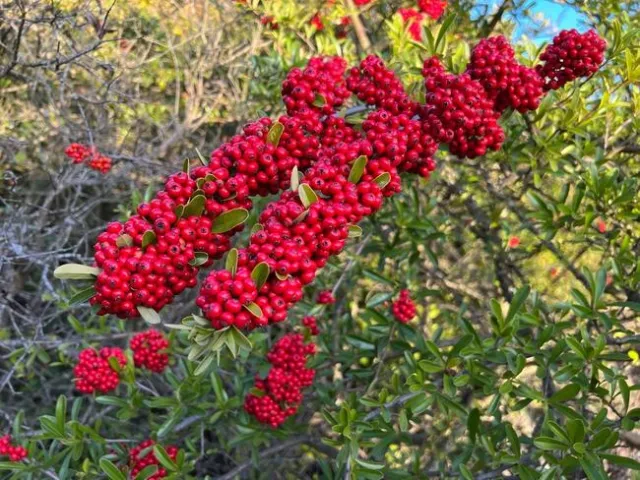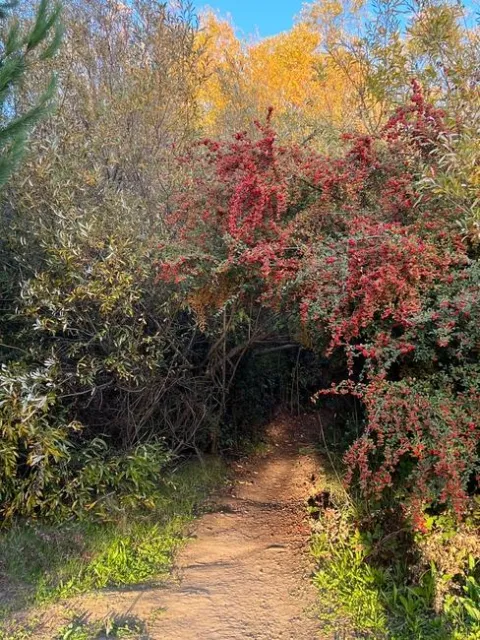In November, as I was strolling in the local park, I noticed a stand of tall shrubs with beautiful, colorful orange and red berries. Some of the shrubs formed an arching tunnel along the path. The plants reminded me of when, as a child, I would watch flocks of robins descend on similar plants and strip them of their berries in mere hours. I was told that the birds would get “drunk” off the berries. I couldn't recall whether the plants were Pyracantha or Toyon or Cotoneaster. Time for research!
Pyracantha
Pyracantha species, also known as firethorn, are evergreen shrubs with bright red or orange berries and spiny branches. Pyracantha is a common ornamental plant in the rose family that has escaped cultivation and is commonly found in disturbed sites, such as along roadsides. The California Invasive Plant Council (Cal-IPC) (https://www.cal-ipc.org) rates one species of Pyracantha, Narrowleaf firethorn (Pyracantha angustifolia), as “limited,” meaning that the species is invasive on a low to moderate rate, but their ecological impacts are minor on a statewide level or there was not enough information to justify a higher invasiveness score. Pyracantha fruits are widely distributed by birds, which leads to the invasiveness of the plant.
Depending on the species,Pyracantha grow in a variety of sizes from compact (2-3 feet tall) to exceeding 15 feet. The plant has glossy green leaves that are 1 to 4 inches long and are generally oval or rounded at the ends. Depending on the variety, the berries provide color from late summer to mid-autumn, with some varieties providing color until late winter. Pyracantha require full sun and moderate water. It is subject tofireblight, scale, woolly aphids, and other pests.

Cotoneaster
Cotoneaster species, which are in the rose family, include both low-growing and tall, hedge-like varieties. The tall plants can take an arching or fountain form. The hedge varieties can be up to 10 feet with white or light pink flower clusters in the spring and red or orange berries in the fall and winter. The ovate leaves can range from ¾ inch to 3 inches and are dull grey-green above and hairy or felty beneath. Birds spread the plant by eating and distributing the seeds.
According to the Cal-IPC, the species is listed by the California Exotic Pest Plant Council on List A-1 (Most Invasive Wildland Pest Plants: Widespread). Cotoneaster franchetii is listed as a moderate risk.

Toyon
The Toyon (Heteromeles arbutifolia), also called the Christmas Berry or California Holly, is a California native that provides an alternative to the Pyracantha and Cotoneaster. The plant also is in the rose family. The Toyon's scientific name is from the Greek words ‘heter' meaning “different” and ‘malus' meaning “apple,” likely because the Toyon berries somewhat resemble tiny apples. The Toyon typically has a shrub form, reaching a height and width of approximately 8 to 10 feet, although some specimens can reach the size of a small tree (up to 30 feet). The dark green leaves are about 3 to 4 inches long with finely serrated edges. Unlike Pyracantha, the Toyon does not have spines. The Toyon has clusters of small white flowers in summer that are attractive to butterflies and insects. In fall and winter, it produces bright red berries that provide food for more than 20 species of birds, and in particular, mockingbirds, robins, finches, and waxwings. Mammals such as coyotes and bears eat the plant.
The Toyon berries and leaves contain a small amount of cyanide compounds that reportedly can be removed by cooking. Native peoples and early settlers cooked the berries and used the leaves and bark to make tea and jelly. [NOTE: The Master Gardeners do not recommend eating any plants picked in the wild without expert identification of the plant and expertise in preparing them.]
The Toyon grows in coastal sage scrub, chaparral, and mixed oak woodland habitats and can grow in a variety of soils, including clay and sand. In the garden setting, the Toyon is a drought-resistant plant that grows in either sun or part shade. It can be used as a hedge plant, and due to its deep roots, it is useful for erosion control and slope stabilization. Despite its size, it tolerates shaping and pruning. The greatest problems are disease promoted from overwatering and fireblight (a disease common to the rose family).
Just for fun, one of several legends about how Hollywood was named is based on the Toyon's abundance in the southern California hills and resemblance to the holly plant. With its glossy green leaves and red berries, people use the Toyon in Christmas arrangements. In fact, collecting Toyon was such a problem in the early 20th Century, that in 1921 the California Legislature adopted Penal Code section 384a to expressly prohibit harvesting the Toyon on public or private land without consent of the landowner. (The law was later expanded to protect native plants more generally.) In 2012, Los Angeles named the Toyon as its official plant.
Now, which plant makes birds “drunk” and why? Many sources identify fermented Pyracantha berries and other fermented fruits, such as blackberries and crapapples, as the culprits.[1] The science behind the fermentation theory, however, is limited. Unlike Pyracantha, most sources state that birds do not get “drunk” on Toyon berries.
After researching this blog, I walked again in the park to identify the plants with the berries. It turned out to be a mix of all three – the arching cotoneaster, the spiny Pyracantha, and native Toyon. If making a choice between planting one of these plants, consider planting the native Toyon to avoid displacing native plants and to provide high-quality habitat for birds and insects that evolved with these native plants.
[1] See, e.g., “Minnesota Residents Call Police On Rowdy Drunk Birds (Oct. 4, 2018) at https://www.npr.org/2018/10/04/654489250/minnesota-residents-call-police-on-rowdy-drunk-birds; “Spring Is in the Air—and So Are Intoxicated Birds” (Mar. 2, 2011) at https://www.audubon.org/news/spring-air-and-so-are-intoxicated-birds.

